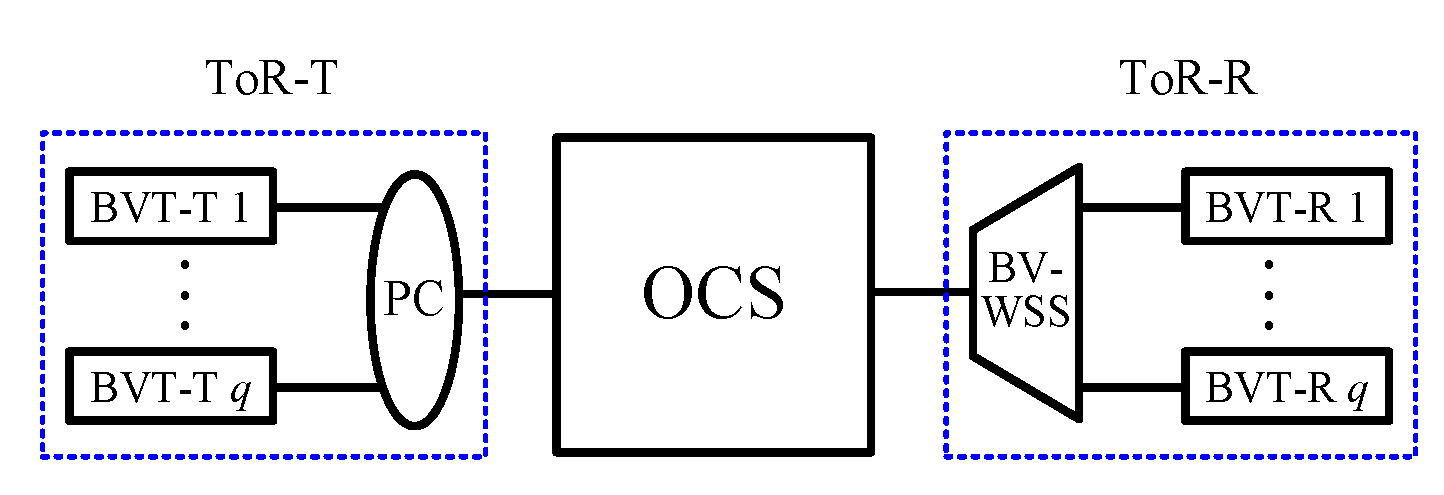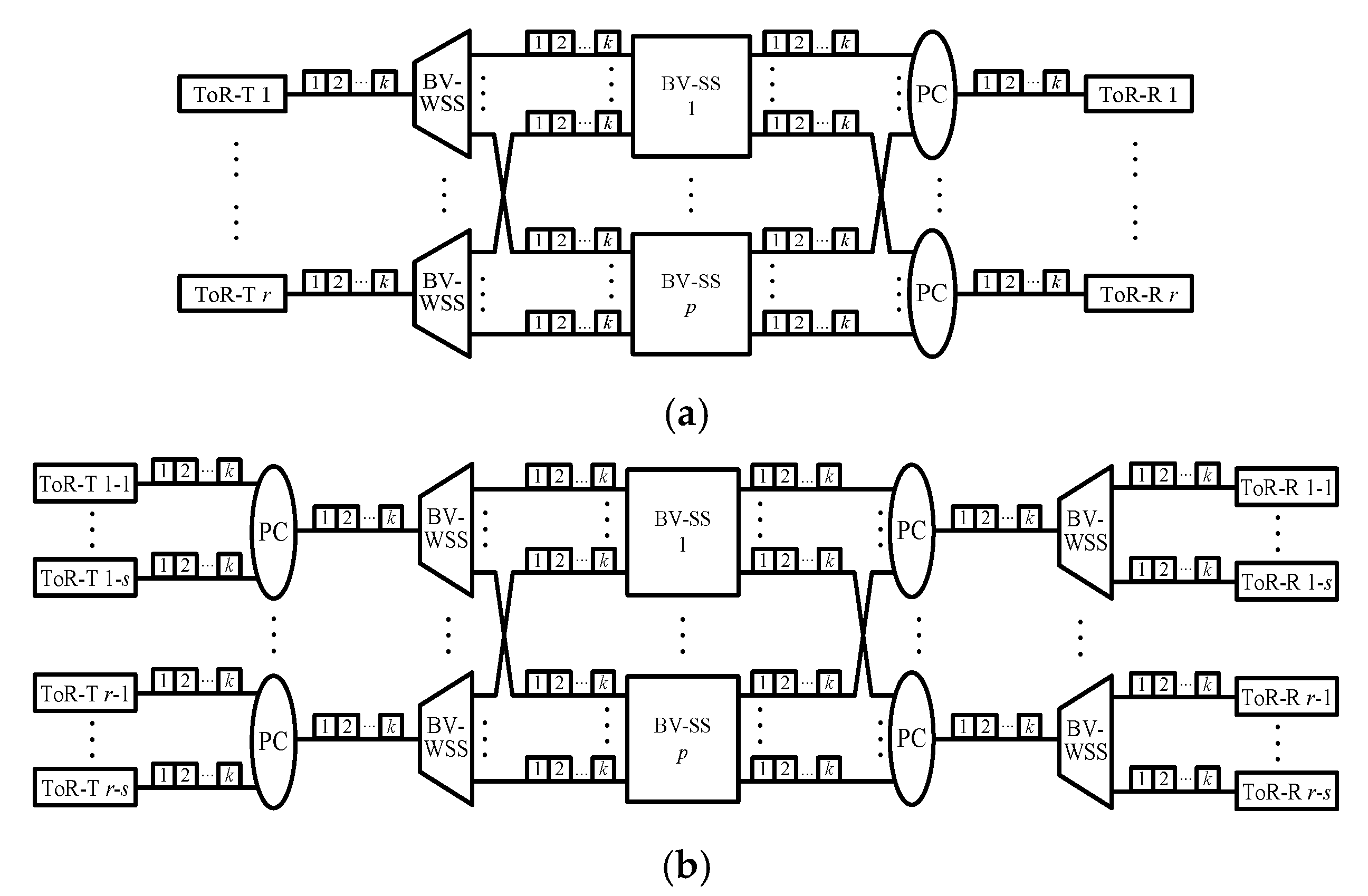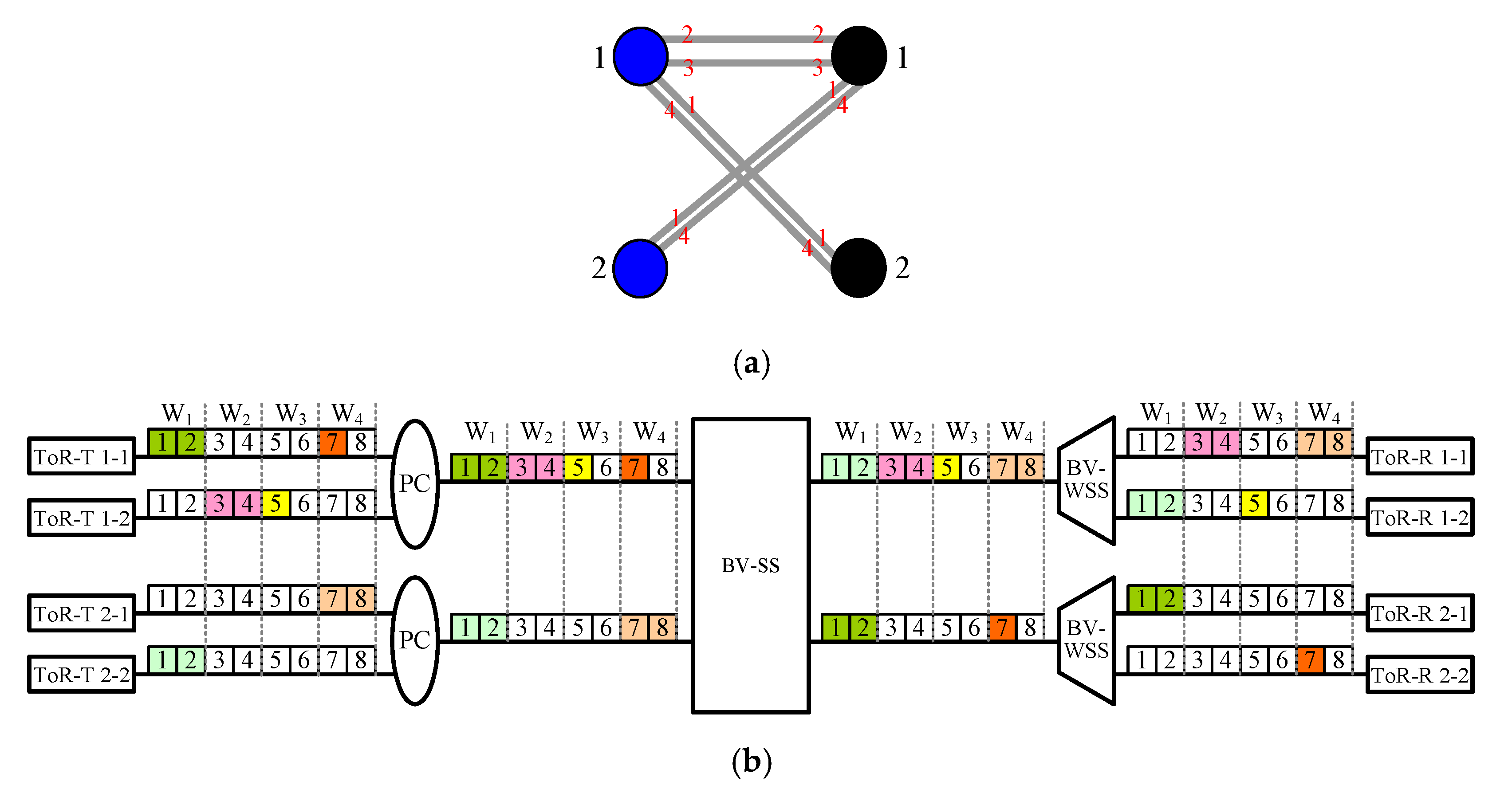Rearrangeable Nonblocking Conditions for Four Elastic Optical Data Center Networks
Abstract
:1. Introduction
2. Preliminaries and Notations
3. RNB DCN1 and DCN3 Networks
3.1. Multigraph Approach and Routing Algorithm
3.2. RNB Sufficient Conditions
4. RNB DCN2 and DCN4 Networks
5. Conclusions
Funding
Conflicts of Interest
References
- Kachris, C.; Tomkos, I. A survey on optical interconnects for data centers. IEEE Commun. Surv. Tutor. 2012, 14, 1021–1036. [Google Scholar] [CrossRef]
- Yoo, S.J.B. Integrated photonic-electronic technologies for next generation data centers and the future internet. In Proceedings of the 2012 International Conference on Photonics in Switching (PS), Ajaccio, France, 11–14 September 2012. [Google Scholar]
- Fiorani, M.; Aleksic, S.; Casoni, M. Hybrid optical switching for data center networks. J. Electr. Comput. Eng. 2014, 2014, 1–13. [Google Scholar] [CrossRef]
- Hamza, A.S.; Deogun, J.S.; Alexander, D.R. Wireless communication in data centers: A survey. IEEE Commun. Surv. Tutor. 2016, 18, 1572–1595. [Google Scholar] [CrossRef] [Green Version]
- Ji, P.N.; Kachris, C.; Tomkos, I.; Wang, T. Energy efficient data center network based on a flexible bandwidth MIMO OFDM optical interconnect. In Proceedings of the 4th IEEE International Conference on Cloud Computing Technology and Science Proceedings, Taipei, Taiwan, 3–6 December 2012. [Google Scholar]
- Kachris, C.; Ji, P.N.; Wang, T.; Tomkos, I. Energy efficient flexible bandwidth OFDM-based data center network. In Proceedings of the 2012 IEEE 1st International Conference on Cloud Networking (CLOUDNET), Paris, France, 28–30 November 2012. [Google Scholar]
- Lopez, V.; Velasco, L. Elastic Optical Networks: Architectures, Technologies, and Control; Springer International Publishing: Cham, Switzerland, 2016. [Google Scholar]
- Kabaciński, W.; AI-Tameemi, A.; Rajewski, R. Necessary and sufficient conditions for the rearrangeability of WSW1 switching fabrics. IEEE Access 2019, 7, 18622–18633. [Google Scholar] [CrossRef]
- Lin, B.-C. Rearrangeable W-S-W elastic optical networks generated by graph approaches. IEEE OSA J. Opt. Commun. Netw. 2018, 10, 675–685. [Google Scholar] [CrossRef]
- Kabaciński, W.; Abdulsahib, M. Wide-sense nonblocking converting-space-converting switching node architecture under XsVarSWITCH control algorithm. IEEE ACM Trans. Netw. 2020, 28, 1550–1561. [Google Scholar] [CrossRef]
- Danilewicz, G. Asymmetrical space-conversion-space SCS1 strict-sense and wide-sense nonblocking switching fabrics for continuous multislot connections. IEEE Access 2019, 7, 107058–107072. [Google Scholar] [CrossRef]
- Spectral Grids for WDM Applications: DWDM Frequency Grid. In ITU-T Standard G.694.1; International Telecommunications Union (CCIR) and (CCITT): Geneva, Switzerland, 2012.
- Kabaciński, W.; Michalski, M.; Rajewski, R.; Żal, M. Optical datacenter networks with elastic optical switches. In Proceedings of the 2017 IEEE International Conference on Communications, Paris, France, 21–25 May 2017. [Google Scholar]
- Hwang, F. The Mathematical Theory of Nonblocking Switching Networks; World Scientific: Singapore, 2004. [Google Scholar]
- 1×9/1×20 Flexgrid® Wavelength Selective Switch (WSS). 2015. Available online: https://www.finisar.com/sites/default/files/downloads/1×9_1×20_flexgrid_wss_pb_v3.pdf (accessed on 18 September 2020).
- Xie, D.; Wang, D.; Zhang, M.; Liu, Z.; You, Q.; Yang, Q.; Yu, S. LCoS-based wavelength-selective switch for future finer-grid elastic optical networks capable of all-optical wavelength conversion. IEEE Photon. J. 2017, 9, 7101212. [Google Scholar] [CrossRef] [Green Version]
- West, D.B. Introduction to Graph Theory; Pearson: London, UK, 2001. [Google Scholar]





| mmax | q = 4 | q = 8 | q = 10 | |||
|---|---|---|---|---|---|---|
| kSNB | kRNB | kSNB | kRNB | kSNB | kRNB | |
| 2 | 20 | 8 | 44 | 16 | 56 | 20 |
| 4 | 46 | 16 | 102 | 32 | 130 | 40 |
| 6 | 72 | 24 | 160 | 48 | 204 | 60 |
| 8 | 98 | 32 | 218 | 64 | 278 | 80 |
| 10 | 124 | 40 | 276 | 80 | 352 | 100 |
| mmax | s = 3, q = 4 | s = 3, q = 8 | s = 3, q = 10 | |||
|---|---|---|---|---|---|---|
| k’SNB | k’RNB | k’SNB | k’RNB | k’SNB | k’RNB | |
| 2 | 68 | 24 | 140 | 48 | 176 | 60 |
| 4 | 158 | 48 | 326 | 96 | 410 | 120 |
| 6 | 248 | 72 | 512 | 144 | 644 | 180 |
| 8 | 338 | 96 | 698 | 192 | 878 | 240 |
| 10 | 428 | 120 | 884 | 240 | 1112 | 300 |
Publisher’s Note: MDPI stays neutral with regard to jurisdictional claims in published maps and institutional affiliations. |
© 2020 by the author. Licensee MDPI, Basel, Switzerland. This article is an open access article distributed under the terms and conditions of the Creative Commons Attribution (CC BY) license (http://creativecommons.org/licenses/by/4.0/).
Share and Cite
Lin, B.-C. Rearrangeable Nonblocking Conditions for Four Elastic Optical Data Center Networks. Appl. Sci. 2020, 10, 7428. https://doi.org/10.3390/app10217428
Lin B-C. Rearrangeable Nonblocking Conditions for Four Elastic Optical Data Center Networks. Applied Sciences. 2020; 10(21):7428. https://doi.org/10.3390/app10217428
Chicago/Turabian StyleLin, Bey-Chi. 2020. "Rearrangeable Nonblocking Conditions for Four Elastic Optical Data Center Networks" Applied Sciences 10, no. 21: 7428. https://doi.org/10.3390/app10217428
APA StyleLin, B.-C. (2020). Rearrangeable Nonblocking Conditions for Four Elastic Optical Data Center Networks. Applied Sciences, 10(21), 7428. https://doi.org/10.3390/app10217428





